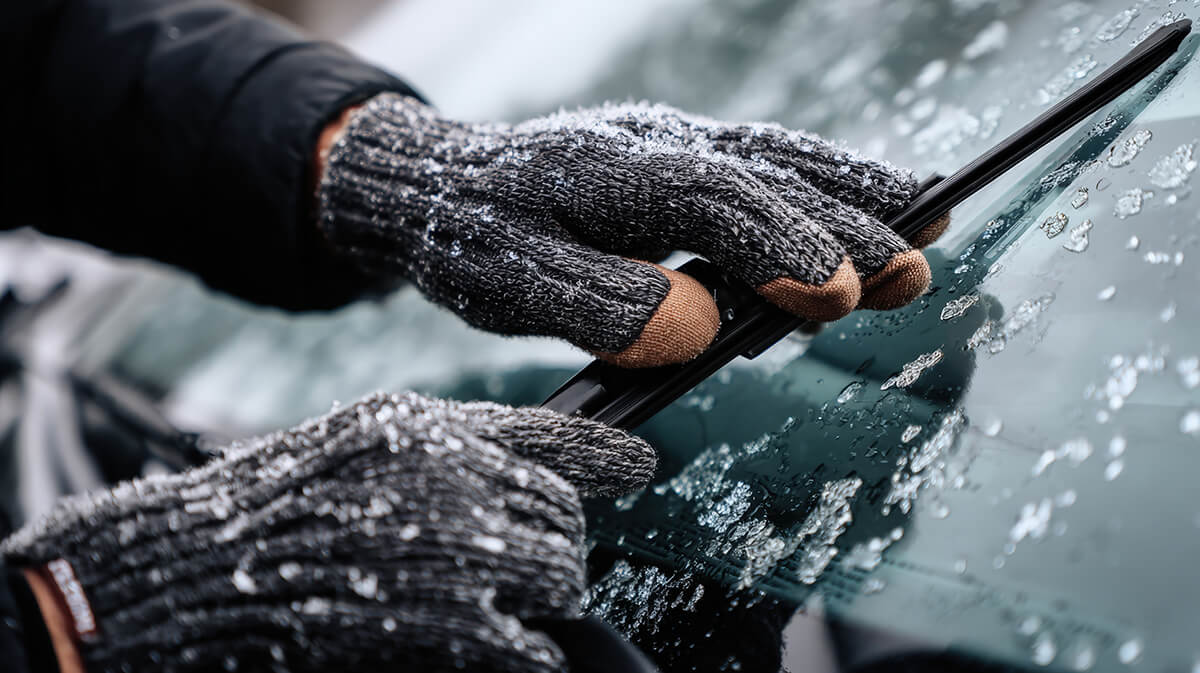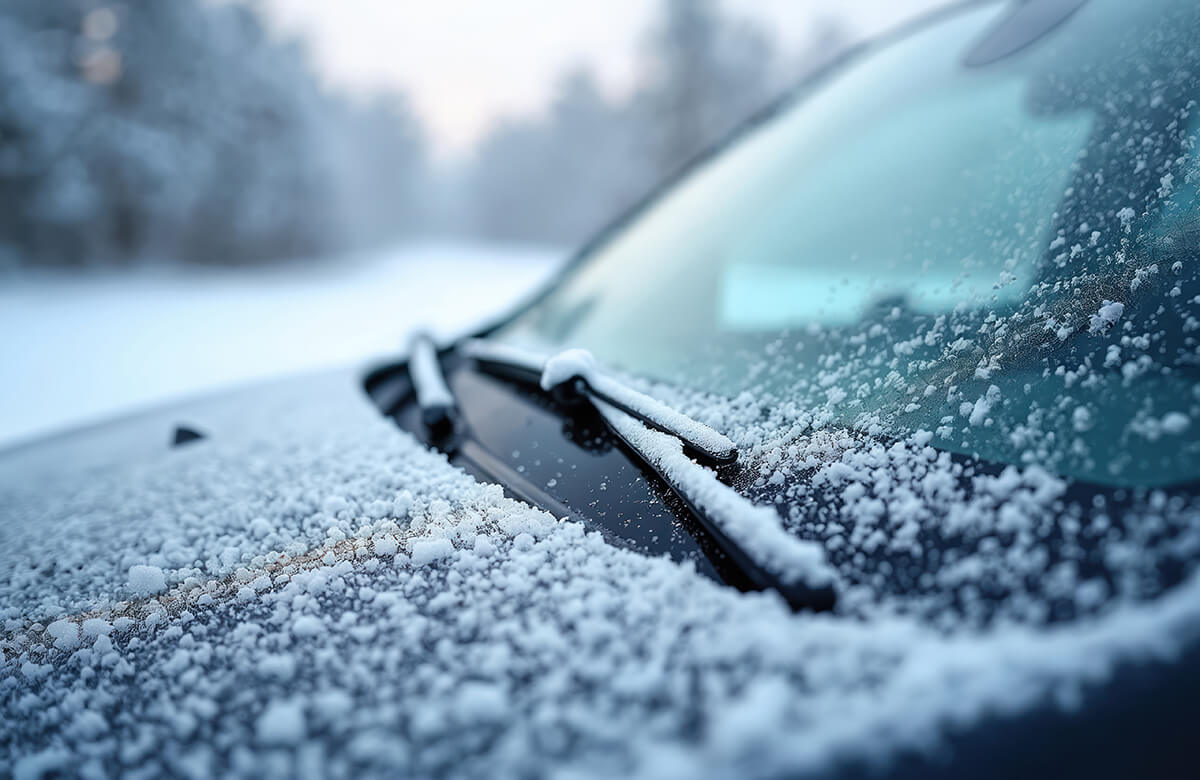
Whether you’re leaving for work or heading out for weekend errands, de-icing your windshield can feel like a tedious chore, especially when the frigid air stings your hands. In a rush, some drivers use quick methods that may seem effective but can damage the glass or reduce visibility.
As an auto glass repair and replacement company, we know that a little care in winter can help you avoid costly windshield damage. This blog will guide you through the best way to remove ice from a windshield, prevent frost overnight, and protect your windshield to maintain clear visibility all winter long.
Effective Methods to Melt Ice on Your Windshield
Before you reach for a scraper, it helps to understand what melts ice on a windshield most effectively. Forcefully scraping thick ice may seem faster, but it can chip the glass or damage the protective coating, especially in extreme cold.
The best way to remove ice from the windshield is by turning on the car’s defroster and letting it run for several minutes before attempting to scrape the surface. This method loosens the bond between the ice and the surface, making it easier to clear without applying excessive force that could damage the windshield.
Does Rubbing Alcohol Melt Ice on Windshields?
If you are in a hurry, spraying rubbing alcohol on your windshield while using your car’s defroster can help speed up the melting process. Rubbing alcohol can melt ice on windshields because it has a much lower freezing point than water, which helps break down the bond between the ice and the glass. A common mixture is two parts rubbing alcohol to one part water, placed in a spray bottle for easy application.
When sprayed evenly across the windshield while activating your car’s defroster, the ice begins to break apart faster because it is being warmed internally and chemically loosened externally. This method not only shortens the time needed to achieve full visibility but also minimizes the amount of scraping required, which helps protect the integrity of your windshield.
Common Improper De-Icing Methods to Avoid

While some de-icing methods like pouring hot water on the glass or using metal tools may seem like they provide a quick solution, they can cause more harm than good by cracking the windshield or scratching the surface. Some common improper de-icing methods drivers should avoid include:
- Pouring hot or boiling water on the glass: Sudden temperature changes can cause the glass to expand and contract rapidly, leading to cracks or even complete shattering.
- Using metal tools or sharp objects: Items like screwdrivers, knives, or metal spatulas can easily scratch the windshield and weaken its structural integrity.
- Forcing frozen wipers to move: Pulling or forcing wiper blades that are stuck to the glass can damage the rubber blades and strain the wiper motor.
- Blasting the defroster at maximum heat immediately: Rapid heating can stress the glass, especially if it already has chips or small cracks.
- Using excessive force when scraping: Applying too much pressure can cause surface scratches or chip the glass.
How to Get Ice Off a Windshield Without a Scraper
During emergency situations when a scraper isn’t available, it is important to use alternatives that will not scratch or stress the glass. Using the wrong tools can cause permanent damage, so focus on methods that safely loosen and melt the ice.
- Lukewarm water in a sealed bag: Fill a resealable plastic bag with lukewarm (not hot) water and gently glide it over the glass. The warmth will help melt the ice without causing thermal shock.
- Credit card or plastic spatula: In a pinch, a sturdy plastic card or a silicone spatula can be used to lift ice. Avoid metal objects, as they can scratch the surface.
- Soft-bristled brush: A clean brush with soft bristles can sweep away loose frost once it has started to melt.
Always work gradually and avoid applying too much pressure, as even light frost can hide small cracks that could spread under stress.
Proven Ways to Stop Ice from Building Up on Your Windshield

“Prevention is better than cure,” while this statement sounds cliché and irrelevant, it’s actually one of the most practical techniques for keeping your windshield clear all winter. Proactive measures not only save you time but also reduce the risk of damage caused by harsh de-icing methods. Here are some practical tips to prevent ice buildup on your windshield overnight:
- Use a windshield cover: A fitted windshield cover acts as a protective barrier, blocking frost and ice from settling on the glass overnight. Removing it in the morning leaves the surface clear of frost.
- Park indoors when possible: Parking in a garage or under a covered area offers effective protection from frost, freezing rain, and snow.
- Apply pre-treatment sprays: Commercial de-icing sprays form a thin layer on the glass that reduces the likelihood of frost and ice from bonding to the surface. For best results, apply it before temperatures drop.
- Vinegar on the windshield to prevent ice: Spray a solution of vinegar and water evenly across the windshield in the evening. This method can reduce frost buildup and make any ice that does form much easier to remove.
Keep Your Windshield in Top Condition During the Winter Season
Effective de-icing starts with knowing what works and what causes damage. By avoiding risky shortcuts and using safe defrosting methods, you protect both your windshield and your safety during the cold winter months. Harsh winters make your auto glass more prone to damage and wear. Whether you’re dealing with a small chip or a significant crack on your windshield, contact Auto Glass Whitby’s skilled team for professional assessment and repair. Get your free quote by filling out this online form.



